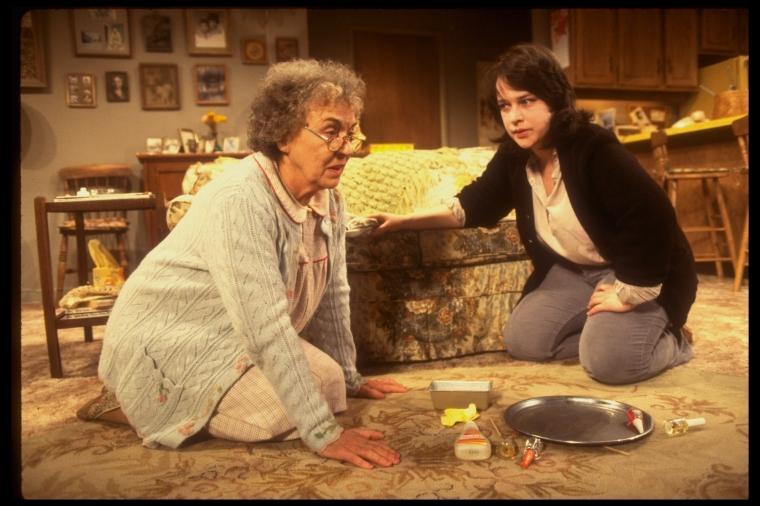Period 1: (until National Anthem); Let's work on developing your characters from the play draft you wrote this past weekend (or in class last Thursday).
For each character in your play, please complete notes and questions from the handout. Set up a "Personal Palette" for your characters (remember that you want to combine people who trigger strong positive or negative feelings in you.)
Answer SOME of the questions as instructed under "Your Character's Physical Life", "Your Character's Inner Life", and "Your Character's Life with Others".
Once you know your characters better, give each character in your play draft (short play draft #1) a monologue where you use some of the details you fleshed out to provide more information to the audience about that character.
Revise and rewrite. Your second draft is NOT due yet.
Period 2:
Please get into groups of 2-4. Read "The Loveliest Afternoon of the Year" by John Guare (see below).
Period 2:
At their core, all plays are about characters in conflict. The five common types of literary conflict include:
- Person v. Person
- Person v. Self
- Person v. Nature (also human nature)
- Person v. Society
- Person v. Fate, the Supernatural, or God
Please get into groups of 2-4. Read "The Loveliest Afternoon of the Year" by John Guare (see below).
As you read the short play "The Loveliest Afternoon of the Year" by John Guare, identify different ways in which the playwright uses conflict as a dramatic centerpiece for the comedy. Take note of the kinds of conflict that occur in the play and write down the type (see above). Select a member of your group to "report out" and post a COMMENT in my COMMENT section of this blog to summarize what you found. Briefly describe what conflict you found working in the play, whether that is a central or major conflict in the play, or a smaller, side conflict that helps to develop character motivations. Finally, make sure your comment includes specific details and examples from the text where you want to make your points.

When your group finishes (reading, discussing and posting), please begin reading the script 'Night Mother by Marsha Norman. Complete a play analysis (handout OR Google Classroom form) for this play. We will discuss both "The Loveliest Afternoon of the Year" and "'Night Mother" next time in class.

Kathy Bates and Anne Pitoniak in the original production of 'Night Mother.
When your group finishes (reading, discussing and posting), please begin reading the script 'Night Mother by Marsha Norman. Complete a play analysis (handout OR Google Classroom form) for this play. We will discuss both "The Loveliest Afternoon of the Year" and "'Night Mother" next time in class.
HOMEWORK: Complete reading 'Night Mother. Complete the play analysis for this play. Due Tuesday, Sept. 24.


7 comments:
In the beginning of the script the conflict is person vs person. the girl and the boy start of arguing over if he was a mugger or not. When they start dating it's still person vs person because they always argue like a happy married couple.
I worked with Makenna and the conflict we found was Person v. Person right from the start of the play because it begins with the "He" and "She" characters going back and forth. We also noticed the He character had a person v. self conflict, it seemed like he was having an internal struggle the entire time he spoke to the She character. The He character said "I'm very hungry" reasoning why he wanted the She character to stop feeding the pigeons proving a Person v. Self conflict.
This play uses Person vs. society conflict because they like each other but society says cheating is wrong. Their relationship is not the norm and the end up getting shot because of it. A quote explaining the conflict between the man and his love for the woman and the expectation that he won't cheat is, "Oh, I can't divorce her. You can divorce a pretty wife for a homely one, but you can't switch an ugly one for a beautiful one." I worked with Tali. :)
One major conflict in the play is that the man was seeing another woman while he was still married to his wife which represents Person v. Self because this conflict lies mostly within the man, himself and not between the woman and the man.
Ex: "Oh, I can't divorce her. You can divorce a pretty wife for a homely one, but you can't switch an ugly one for a beautiful one."(Guare 27) ~ Valerie and A'layza.
I worked with tia and aalaysia and the conflict in the text was person v person from when the girl and the boy start to argue.
I worked with my boi Wes. The conflict started out as Person vs person, as HE is hungry and asks SHE for food but SHE doesn't trust HE and becomes suspicious that HE is a mugger. She says "Are you a mugger?"(p.21) in distrust of HE. The second conflict is Person vs. self as SHE states in her monologue(?) that she was lonely and in all of eleven months "...you(HE) are the first person I've(SHE) have spoken to"(p.22). There's another Person vs Person when there conflict between HE and She during their love time near the merry go around.
The conflict in the play is person vs person because it is the boy vs the girl. The boy and the girl argue during the play because the girl is suspicious of the boy. That makes the conflict person v person because it is boy vs girl.
Post a Comment